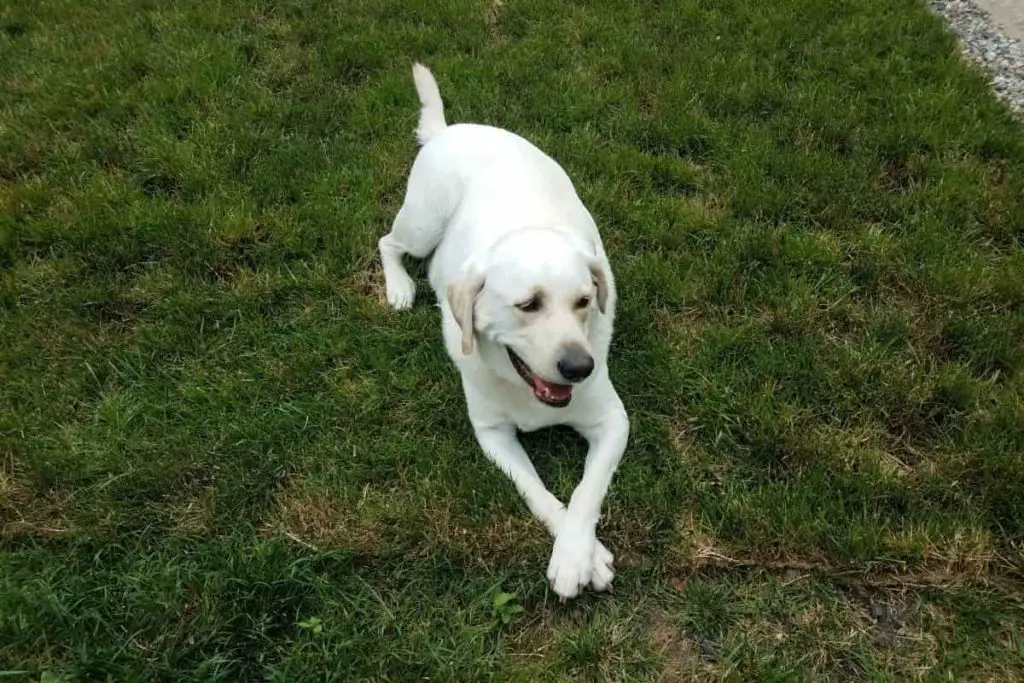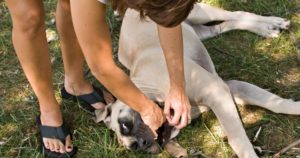Why do dogs cross their paws? This is a pretty common question amongst good pet owners who pay close attention to their beloved animal friend’s body language.
It is very important for pet owners, and especially large dog owners, to pay close attention to pet body language. Your dog’s body language offers a lot of information about the type of emotions your pet might be experiencing at a given time and can inform you when the dog is feeling relaxed, anxious, or agitated.
In this guide, we are going to take a closer look at the reason your dog might be crossing its paws when it lies down so you can better understand your furry friend.
Why Do Dogs Cross Their Paws?
There are several reasons your dog might be crossing its paws. The most common reason your pet is crossing its front paws when it lies down is that it is simply comfortable or happy. But this body gesture can mean different things for different dog breeds. In some breeds, it could be an alarming position, or it could mean that your pet might be trying to communicate something to you. Here is a quick look at the main reasons your dog might be crossing its legs.
To Communicate an Emotion
Unlike humans, pets have to rely on body language, tails, or paws to communicate several emotions. Since each pet is different and has a unique character and communication method, it is important to study your pet when he or she is crossing its paws. Pretty soon, you will uncover the message behind this human-like expression. For some dogs, it can be a sign that the dog is feeling ill. For others, it could be that your dog is communicating that it is content.
Your Pet Might Feel Comfortable
Humans often cross their legs when they take a rest because this sitting or lying position can feel very comfortable. Humans also cross their legs when they sit on an uncomfortable chair in an attempt to feel comfier in that position.
As with humans, your dog might be crossing its paws when it feels comfortable or is trying to achieve a more comfortable position on an uncomfortable surface.
A dog that crosses its paw for comfort reasons will often do this while resting, lying in the sun, or enjoying a deep sleep in front of a cozy fireplace.
It Could Be a Sign of Happiness
Many pet experts believe that some pets express their happiness or contentment by crossing their front paws. A lot of pets find this position very comfortable since it takes some of the pressure off certain bones in their legs. This is, however, not always the case with all dogs and breeds.
If your dog crosses its legs after doing something pleasurable like taking a walk, eating a delicious dinner,or getting petted, then it could be a sign of affection or happiness.
Your Dog Could Be Alert or Sad
Some dog breeds may adopt this position when they need to stay alert or when they feel alarmed. This is because the crossed leg position is easy to rise from if the dog is planning on sprinting in the near future. Guard dogs like German Shepherds orDobermansoften adopt this alert position. With these dogs, you might notice your pet’s ears stay upright or twitch in different directions as he or she keeps listening for alarming noises.
Some dogs might also adopt this position when they feel sad and want to communicate that they are moping. In this case, your dog will likely lie down with his or her head flat on top of their legs, their ears will be pulled back or downward, and their eyes will look sad and droopy.
The Behavior Is More Common in Certain Breeds
Dog breeds vary a lot in body build type, and some feel a lot more comfortable with crossed paws than others.

LabradorsandBorder Collies, for example, have thin chests with long legs that allow them to easily cross their front paws when they lie down.
Bulldogs and Basset Hounds, on the other hand, have broader chests with shorter legs. These dog breeds are not often seen crossing their front paws because it can be uncomfortable and add pressure to the shoulder blades.
The Behavior Could Be Trained
Pet owners love to teach their beloved animals all sorts of tricks and behaviors. These behaviors can make pets seem more polite in social settings.
Some pet owners might teach their dogs to cross their front paws because this lying position is visually appealing and comforting and it looks polite. Dogs are creatures of habit. If they become used to being rewarded for a certain trick, like a specific sleeping position, they might start naturally adopting this position in an attempt to seek positive reinforcement or to get a treat.
Do All Dogs Cross Their Paws?
No, all dogs do not cross their paws. Some dogs are very likely to naturally adopt this common position while others rarely or never cross their paws when lying down. It is also true that dog breeds with long legs are much more likely to cross their paws than dog breeds with short legs and stout bodies. This is because long limbs are easy to naturally cross when the dog lies flat on its elbows, while dogs with short legs will need to make an effort to cross their paws.
Can You Train a Dog to Cross Paws?
Yes, you can train a furry friend to cross its front paws, and most dogs pick up this trick relatively easily. Dogs with longer limbs are also very likely to adopt this trick as a permanent behavior, since they naturally feel comfortable with this adorable sleeping position. But for dogs with shorter bodies like bulldogs, you will need to give a command every time you request them to cross their front paws because they feel uncomfortable in this position.
How Do You Teach a Dog to Cross Its Front Paws?
Teaching your dog to cross its paws is quite simple, but it will take some time and patience. The best way to teach your dog this type of trick is with positive reinforcement.
Start by obtaining a healthy snack that your dog enjoys eating. The treats should be small in size so you can practice frequently without overfeeding the animal.
Choose a command gesture to use when you are requesting your dog to perform that specific trick. It can be something simple like “cross.”
Once you have treats, you can start by teaching your dog to touch your hand with its left paw. Give the chosen command every time you want the pet to perform the trick and touch your dog’s left paw. Offer a treat when the dog obeys the command and keep practicing until your pet understands what is expected.
Now start moving your hand towards the other paw. Keep repeating this practice and reward system until your dog successfully touches your hand with its left paw while holding your hand over the pet’s right paw.
Keep practicing until your dog naturally starts crossing its paws every time you give the command. Pretty soon, your pet will start obeying without any hand gestures.
It is important to reward your pet’s trick with snacks and positive affirmation and to keep in mind that your dog might take several days or weeks to fully master this technique.
Final Thoughts
So, why do dogs cross their paws? This firstly depends on the animal’s breed. Breeds with longer limbs naturally find this position enjoyable, while animals with short legs may find it uncomfortable. Secondly, the message your dog is conveying may differ depending on the character of your pet. Some dogs cross their legs when they feel comfortable or as a sign that they are content. Some dogs may cross their legs if they want to communicate sad emotions. And some dogs like guard dogs might choose this position when they don’t feel at ease with their environment and want to be able to get up and run in an instant.
In the end, it is up to the pet owner to study and analyze all sorts of body language positions or features so they can unravel the reason their animal might be crossing its paws. Once you determine your dog’s character and communication, it will be easy to figure out what your dog is feeling or trying to convey whenever they cross their paws.
We hope that you found this guide useful. If you want to learn more about your pup or find out what other body gestures might mean, then you should have a look at some of the other guides we have on Natural Puppies. Our website has everything you need to know about dogs and all of their unique needs and emotions.






